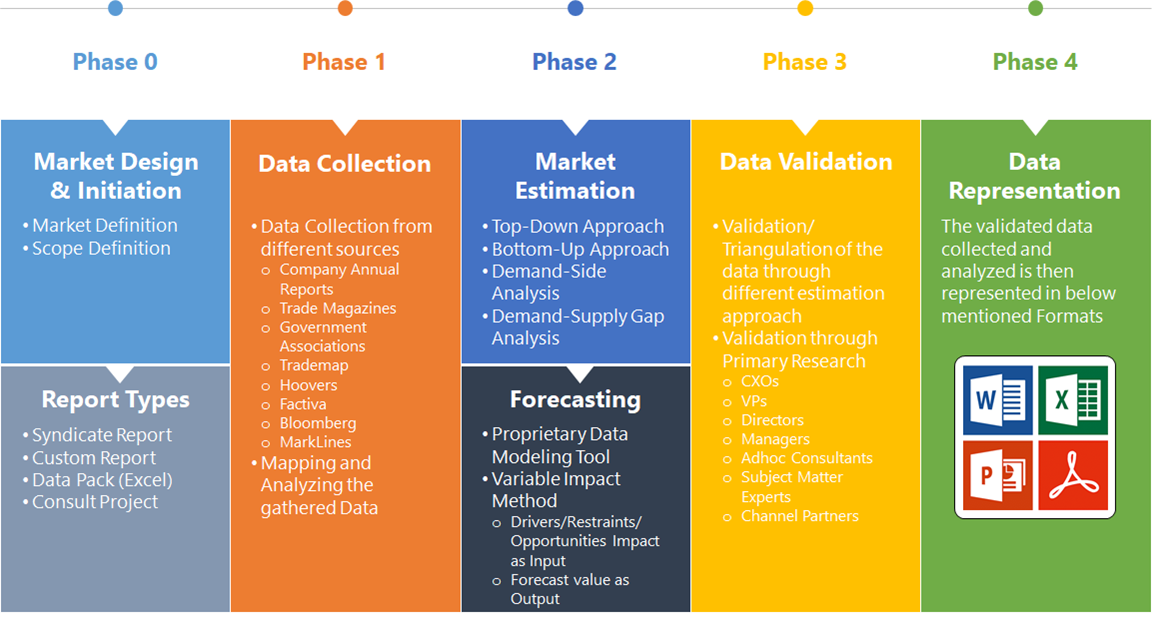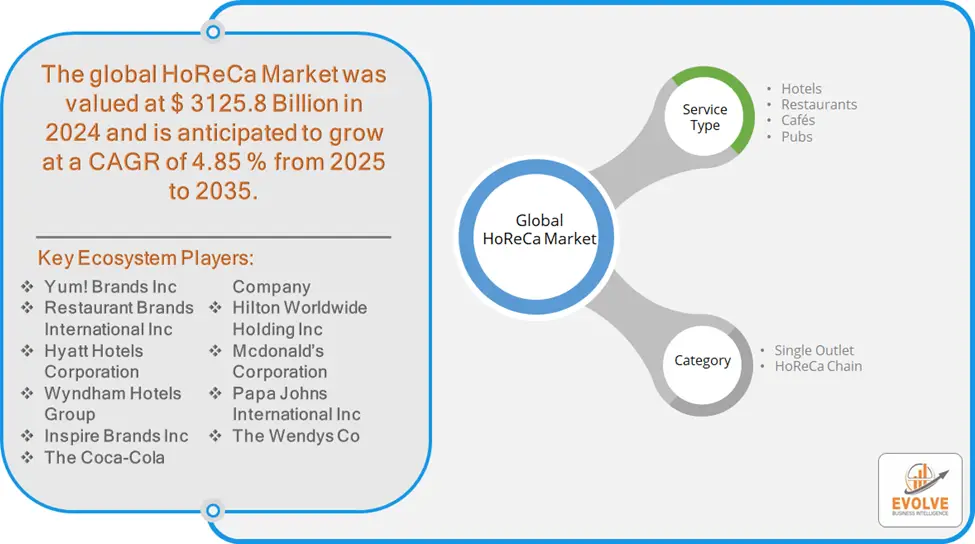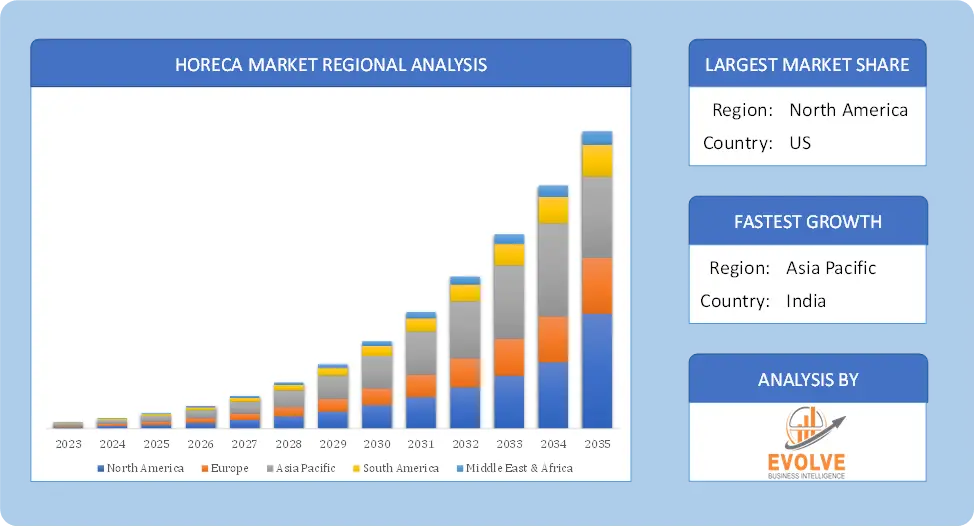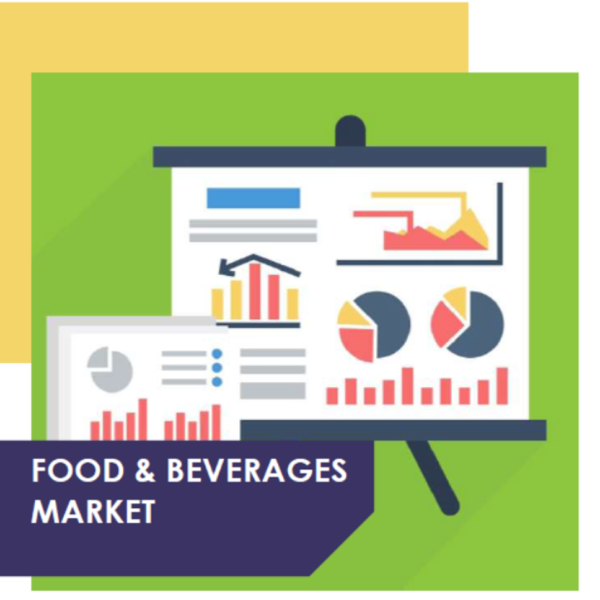HoReCa Market Analysis and Global Forecast 2023-2035
$ 1,390.00 – $ 5,520.00Price range: $ 1,390.00 through $ 5,520.00
HoReCa Market Research Report: Information By Service Type (Hotels, Restaurants, Cafés, Pubs), By Category (Single Outlet, HoReCa Chain), and by Region — Forecast till 2035
Page: 116
HoReCa Market Overview
The HoReCa Market size accounted for 3125.8 Billion in 2024 growing at a compound annual growth rate (CAGR) of 4.85% from 2025 to 2035. The HoReCa market represents the global food service and hospitality industry, covering hotels, restaurants, cafés, catering services, and other dining establishments. It is a critical part of the broader service economy, deeply linked to tourism, urbanization, lifestyle shifts, and consumer spending trends. The market thrives on providing dining, accommodation, and catering experiences while adapting to evolving consumer preferences for convenience, quality, and sustainability.
In recent years, the HoReCa sector has been shaped by several strong trends: rising disposable incomes, rapid urban development, increased travel and tourism, and the growing demand for diverse and global cuisines. The sector is also heavily influenced by technology adoption ranging from digital ordering platforms, online reservations, delivery services, and cloud kitchens to AI-driven customer engagement and data analytics for personalized services.
Global HoReCa Market Synopsis
 HoReCa Market Dynamics
HoReCa Market Dynamics
The major factors that have impacted the growth of HoReCa Market are as follows:
Drivers:
- Rising Tourism & Business Travel
One of the major factors driving the growth of the HoReCa market is the steady rise in tourism and business travel worldwide. As international tourism rebounds post-pandemic and more countries invest in promoting travel and hospitality, demand for hotels, restaurants, and catering services has surged. Business travel, fueled by globalization, international trade, corporate events, and conferences, further boosts the sector by creating consistent demand for accommodations, dining, and event hosting services. Popular tourist destinations, both emerging and established, continue to expand their hospitality infrastructure to cater to diverse traveler preferences, from luxury resorts and fine dining to budget hotels and casual eateries. Moreover, governments in regions such as the Middle East, Southeast Asia, and Europe are investing heavily in tourism infrastructure and global events, such as expos, cultural festivals, and sports tournaments, which significantly benefit the HoReCa industry. This consistent inflow of both leisure and business travelers ensures a growing customer base, making tourism and business travel one of the strongest pillars supporting the global HoReCa market’s expansion.
Restraint:
- Economic Uncertainty & Inflation
A key restraint impacting the HoReCa market is economic uncertainty and inflation. The sector is highly sensitive to fluctuations in consumer spending, as dining out, hotel stays, and leisure activities are often considered discretionary expenses. When inflation rises, the cost of food, beverages, utilities, transportation, and labor also increases, putting pressure on already thin profit margins for hotels, restaurants, and catering services. At the same time, consumers facing higher living costs tend to cut back on non-essential spending, leading to reduced footfall in restaurants and lower occupancy rates in hotels. Economic slowdowns or recessions exacerbate this issue, as both leisure travelers and corporate clients scale back on travel, events, and hospitality budgets. For smaller and independent HoReCa operators, the inability to absorb or pass on rising costs to price-sensitive customers can further threaten profitability and sustainability. This makes economic uncertainty and inflation a significant barrier to stable growth in the global HoReCa market.
Opportunity:
⮚ Growth of Online Food Delivery & Cloud Kitchens
One of the most promising opportunities in the HoReCa market is the rapid growth of online food delivery and cloud kitchens. With changing consumer lifestyles, increasing urbanization, and the rising preference for convenience, food delivery has become a mainstream channel for restaurants and cafés to reach customers beyond their physical locations. The widespread adoption of smartphones, digital payment systems, and aggregator platforms such as Uber Eats, DoorDash, Swiggy, and Zomato has made online ordering seamless and accessible. At the same time, cloud kitchens—delivery-only kitchens without dine-in facilities—are gaining traction as they allow businesses to operate with lower overhead costs, flexible location choices, and faster scalability. These models enable HoReCa operators to serve a larger customer base, test new concepts, and optimize operations without the high expenses associated with traditional restaurants. As consumer demand for quick, affordable, and diverse dining options continues to grow, online food delivery and cloud kitchens present a significant long-term growth opportunity, reshaping the future of the HoReCa industry.
By Service Type
Based on Service Type, the market is segmented into Hotels, Restaurants, Cafés, Pubs. The restaurant segment represents the largest share of the industry. Restaurants dominate because they cater to a wide range of consumer needs—ranging from quick-service and casual dining to fine dining and specialty cuisines. Unlike hotels or pubs, restaurants benefit from high-frequency consumer visits, as eating out has become an integral part of urban lifestyles driven by busy schedules, higher disposable incomes, and the cultural trend of social dining..
By Category
Based on Category, the market segment has been divided into the Single Outlet and, HoReCa Chain. Single outlets dominate in terms of the number of establishments, especially in developing regions where independent hotels, restaurants, and cafés are widespread. These outlets often cater to local tastes, provide personalized services, and have strong connections with their communities. They are particularly attractive to consumers looking for authentic, niche, or regional experiences that larger chains may not offer. However, they face challenges in terms of limited scalability, higher vulnerability to economic fluctuations, and rising competition from global and regional chains. Despite this, single outlets remain a critical part of the HoReCa ecosystem due to their adaptability, cultural uniqueness, and customer loyalty.
Global HoReCa Market Regional Analysis
Based on region, the global HoReCa Market has been divided into North America, Europe, Asia-Pacific, the Middle East & Africa, and Latin America. North America is projected to dominate the use of the HoReCa Market followed by the Asia-Pacific and Europe regions.
 North America Market
North America Market
North America holds a dominant position in the HoReCa Market. North America holds a significant share of the global HoReCa market, led by the United States and Canada, where high consumer spending, a strong culture of dining out, and well-established hotel and restaurant chains dominate the landscape. Quick-service restaurants (QSRs) and premium dining experiences are both popular, while innovations in food delivery, cloud kitchens, and sustainable dining further drive growth. The region also benefits from a robust business travel and tourism sector, particularly in major cities like New York, Los Angeles, Toronto, and Miami.
Asia-Pacific Market
The Asia-Pacific region has indeed emerged as the fastest-growing for the HoReCa Market. Asia-Pacific is the fastest-growing region in the HoReCa market, driven by rapid urbanization, rising disposable incomes, a young population, and booming tourism. Countries like China, India, Japan, Thailand, and Indonesia are witnessing an expansion of both international hotel chains and local dining establishments. The growing influence of food delivery platforms, coupled with the demand for diverse cuisines, has transformed the restaurant and café segment. Major global events, regional tourism growth, and lifestyle changes are expected to keep Asia-Pacific at the forefront of HoReCa market expansion.
Competitive Landscape
The global HoReCa Market is highly competitive, with numerous players offering a wide range of software solutions. The competitive landscape is characterized by the presence of established companies, as well as emerging startups and niche players. To increase their market position and attract a wide consumer base, the businesses are employing various strategies, such as product launches, and strategic alliances.
Prominent Players:
- Yum! Brands Inc
- Restaurant Brands International Inc
- Hyatt Hotels Corporation
- Wyndham Hotels Group
- Inspire Brands Inc
- The Coca-Cola Company
- Hilton Worldwide Holding Inc
- Mcdonald’s Corporation
- Papa Johns International Inc
- The Wendys Co
Scope of the Report
Global HoReCa Market, by Service Type
- Hotels
- Restaurants
- Cafés
- Pubs
Global HoReCa Market, by Category
- Single Outlet
- HoReCa Chain
Global HoReCa Market, by Region
- North America
- US
- Canada
- Mexico
- Europe
- UK
- Germany
- France
- Italy
- Spain
- Benelux
- Nordic
- Rest of Europe
- Asia Pacific
- China
- Japan
- South Korea
- Indonesia
- Austalia
- Malaysia
- India
- Rest of Asia Pacific
- South America
- Brazil
- Argentina
- Rest of SouthAmerica
- Middle East &Africa
- Saudi Arabia
- UAE
- Egypt
- SouthAfrica
- Rest of Middle East & Africa
| Parameters | Indicators |
| Market Size | 2024: USD 3125.8 Billion |
| CAGR (2025-2035) | 4.85% |
| Base year | 2024 |
| Forecast Period | 2025-2035 |
| Historical Data | 2023 (2023 to 2035 On Demand) |
| Report Coverage | Revenue Forecast, Competitive Landscape, Growth Factors, and Trends |
| Key Segmentations | Segment Type, Category |
| Geographies Covered | North America, Europe, Asia-Pacific, South America, Middle East, Africa |
| Key Vendors | Yum! Brands Inc, Restaurant Brands International Inc, Hyatt Hotels Corporation, Wyndham Hotels Group, Inspire Brands Inc, The Coca-Cola Company, Hilton Worldwide Holding Inc, Mcdonald’s Corporation, Papa Johns International Inc, The Wendys Co |
| Key Market Opportunities | · Growth of Online Food Delivery & Cloud Kitchens |
| Key Market Drivers | · Rising Tourism & Business Travel. |
REPORT CONTENT BRIEF:
- High-level analysis of the current and future HoReCa Market trends and opportunities
- Detailed analysis of current market drivers, restraining factors, and opportunities in the future
- HoReCa Market historical market size for the year 2021, and forecast from 2023 to 2033
- HoReCa Market share analysis at each product level
- Competitor analysis with detailed insight into its product segment, Government & Defense strength, and strategies adopted.
- Identifies key strategies adopted including product launches and developments, mergers and acquisitions, joint ventures, collaborations, and partnerships as well as funding taken and investment done, among others.
- To identify and understand the various factors involved in the global HoReCa Market affected by the pandemic
- To provide a detailed insight into the major companies operating in the market. The profiling will include the Government & Defense health of the company’s past 2-3 years with segmental and regional revenue breakup, product offering, recent developments, SWOT analysis, and key strategies.
Frequently Asked Questions (FAQ)
What is the study period of this market?
The study period of the global HoReCa Market is 2025- 2035
What is the growth rate of the global HoReCa Market?
The global HoReCa Market is growing at a CAGR of 4.85% over the next 10 years
Which region has the highest growth rate in the market of HoReCa Market?
Asia Pacific is expected to register the highest CAGR during 2023-2035
Which region has the largest share of the global HoReCa Market?
North America holds the largest share in 2022
Who are the key players in the global HoReCa Market?
Yum! Brands Inc, Restaurant Brands International Inc, Hyatt Hotels Corporation, Wyndham Hotels Group, Inspire Brands Inc, The Coca-Cola Company, Hilton Worldwide Holding Inc, Mcdonald’s Corporation, Papa Johns International Inc, The Wendys Co are the major companies operating in the market.
Do you offer Post Sale Support?
Yes, we offer 16 hours of analyst support to solve the queries
Do you sell particular sections of a report?
Yes, we provide regional as well as country-level reports. Other than this we also provide a sectional report. Please get in contact with our sales representatives.
Press Release

Global Pharmaceutical Manufacturing Market to Reach $1.38 Trillion by 2035 with 7.35% CAGR, New Research Shows

The Global Mammography Market Is Estimated To Record a CAGR of Around 10.29% During The Forecast Period

Glue Stick Market to Reach USD 2.35 Billion by 2034

Podiatry Service Market to Reach USD 11.88 Billion by 2034

Microfluidics Technology Market to Reach USD 32.58 Billion by 2034

Ferric Chloride Market to Reach USD 10.65 Billion by 2034

Family Practice EMR Software Market to Reach USD 21.52 Billion by 2034

Electric Hairbrush Market to Reach USD 15.95 Billion by 2034

Daily Bamboo Products Market to Reach USD 143.52 Billion by 2034

Cross-border E-commerce Logistics Market to Reach USD 112.65 Billion by 2034
Table of Content
Chapter 1. Executive Summary
Chapter 2. Scope Of The Study
2.1. Market Definition
2.2. Scope Of The Study
2.2.1. Objectives of Report
2.2.2. Limitations
2.3. Market Structure
Chapter 3. Evolve BI Methodology
Chapter 4. Market Insights and Trends
4.1. Supply/ Value Chain Analysis
4.1.1. Raw Categorys Providers
4.1.2. Manufacturing Process
4.1.3. Distributors/Retailers
4.1.4. End-Use Industry
4.2. Porter’s Five Forces Analysis
4.2.1. Threat Of New Entrants
4.2.2. Bargaining Power Of Buyers
4.2.3. Bargaining Power Of Suppliers
4.2.4. Threat Of Substitutes
4.2.5. Industry Rivalry
4.3. Impact Of COVID-19 on the HoReCa Market
4.3.1. Impact on Market Size
4.3.2. End-Use Industry Trend, Preferences, and Budget Impact
4.3.3. Regulatory Framework/Government Policies
4.3.4. Key Players' Strategy to Tackle Negative Impact
4.3.5. Opportunity Window
4.4. Technology Overview
12.28. Macro factor
4.6. Micro Factor
4.7. Demand Supply Gap Analysis of the HoReCa Market
4.8. Import Analysis of the HoReCa Market
4.9. Export Analysis of the HoReCa Market
Chapter 5. Market Dynamics
5.1. Introduction
5.2. DROC Analysis
5.2.1. Drivers
5.2.2. Restraints
5.2.3. Opportunities
5.2.4. Challenges
5.3. Patent Analysis
5.4. Industry Roadmap
5.5. Parent/Peer Market Analysis
Chapter 6. Global HoReCa Market, By Service Type
6.1. Introduction
6.2. Hotels
6.3. Restaurants
6.4. Cafes
6.4. Pubs
Chapter 7. Global HoReCa Market, By Category
7.1. Introduction
7.2. Single Outlet
7.3. HoReCa Chain
Chapter 8. Global HoReCa Market, By Region
8.1. Introduction
8.2. North America
8.2.1. Introduction
8.2.2. Driving Factors, Opportunity Analyzed, and Key Trends
8.2.3. Market Size and Forecast, By Country, 2025-2035
8.2.4. Market Size and Forecast, By Service Type, 2025-2035
8.2.5. Market Size and Forecast, By Category, 2025-2035
8.2.6. US
8.2.6.1. Introduction
8.2.6.2. Driving Factors, Opportunity Analyzed, and Key Trends
8.2.6.3. Market Size and Forecast, By Service Type, 2025-2035
8.2.6.4. Market Size and Forecast, By Category, 2025-2035
8.2.7. Canada
8.2.7.1. Introduction
8.2.7.2. Driving Factors, Opportunity Analyzed, and Key Trends
8.2.7.4. Market Size and Forecast, By Service Type, 2025-2035
8.2.7.5. Market Size and Forecast, By Category, 2025-2035
8.3. Europe
8.3.1. Introduction
8.3.2. Driving Factors, Opportunity Analyzed, and Key Trends
8.3.3. Market Size and Forecast, By Country, 2025-2035
8.3.4. Market Size and Forecast, By Service Type, 2025-2035
8.3.5. Market Size and Forecast, By Category, 2025-2035
8.3.6. Germany
8.3.6.1. Introduction
8.3.6.2. Driving Factors, Opportunity Analyzed, and Key Trends
8.3.6.3. Market Size and Forecast, By Service Type, 2025-2035
8.3.6.4. Market Size and Forecast, By Category, 2025-2035
8.3.7. France
8.3.7.1. Introduction
8.3.7.2. Driving Factors, Opportunity Analyzed, and Key Trends
8.3.7.3. Market Size and Forecast, By Service Type, 2025-2035
8.3.7.4. Market Size and Forecast, By Category, 2025-2035
8.3.8. UK
8.3.8.1. Introduction
8.3.8.2. Driving Factors, Opportunity Analyzed, and Key Trends
8.3.8.3. Market Size and Forecast, By Service Type, 2025-2035
8.3.8.4. Market Size and Forecast, By Category, 2025-2035
8.3.9. Italy
8.3.9.1. Introduction
8.3.9.2. Driving Factors, Opportunity Analyzed, and Key Trends
8.3.9.3. Market Size and Forecast, By Service Type, 2025-2035
8.3.9.4. Market Size and Forecast, By Category, 2025-2035
8.3.11. Rest Of Europe
8.3.11.1. Introduction
8.3.11.2. Driving Factors, Opportunity Analyzed, and Key Trends
8.3.11.3. Market Size and Forecast, By Service Type, 2025-2035
8.3.11.4. Market Size and Forecast, By Category, 2025-2035
8.4. Asia-Pacific
8.4.1. Introduction
8.4.2. Driving Factors, Opportunity Analyzed, and Key Trends
8.4.3. Market Size and Forecast, By Country, 2025-2035
8.4.4. Market Size and Forecast, By Service Type, 2025-2035
8.12.28. Market Size and Forecast, By Category, 2025-2035
8.4.6. China
8.4.6.1. Introduction
8.4.6.2. Driving Factors, Opportunity Analyzed, and Key Trends
8.4.6.3. Market Size and Forecast, By Service Type, 2025-2035
8.4.6.4. Market Size and Forecast, By Category, 2025-2035
8.4.7. India
8.4.7.1. Introduction
8.4.7.2. Driving Factors, Opportunity Analyzed, and Key Trends
8.4.7.3. Market Size and Forecast, By Service Type, 2025-2035
8.4.7.4. Market Size and Forecast, By Category, 2025-2035
8.4.8. Japan
8.4.8.1. Introduction
8.4.8.2. Driving Factors, Opportunity Analyzed, and Key Trends
8.4.8.3. Market Size and Forecast, By Service Type, 2025-2035
8.4.8.4. Market Size and Forecast, By Category, 2025-2035
8.4.9. South Korea
8.4.9.1. Introduction
8.4.9.2. Driving Factors, Opportunity Analyzed, and Key Trends
8.4.9.3. Market Size and Forecast, By Service Type, 2025-2035
8.4.9.4. Market Size and Forecast, By Category, 2025-2035
8.4.10. Rest Of Asia-Pacific
8.4.10.1. Introduction
8.4.10.2. Driving Factors, Opportunity Analyzed, and Key Trends
8.4.10.3. Market Size and Forecast, By Service Type, 2025-2035
8.4.10.4. Market Size and Forecast, By Category, 2025-2035
8.5. Rest Of The World (RoW)
8.5.1. Introduction
8.5.2. Driving Factors, Opportunity Analyzed, and Key Trends
8.5.3. Market Size and Forecast, By Service Type, 2025-2035
8.5.4. Market Size and Forecast, By Category, 2025-2035
Chapter 9. Company Landscape
9.1. Introduction
9.2. Vendor Share Analysis
9.3. Key Development Analysis
9.4. Competitor Dashboard
Chapter 10. Company Profiles
10.1. Yum! Brands Inc
10.1.1. Business Overview
10.1.2. Government & Defense Analysis
10.1.2.1. Government & Defense – Existing/Funding
10.1.3. Product Portfolio
10.1.4. Recent Development and Strategies Adopted
10.1.5. SWOT Analysis
10.2. Restaurant Brands International Inc
10.2.1. Business Overview
10.2.2. Government & Defense Analysis
10.2.2.1. Government & Defense – Existing/Funding
10.2.3. Product Portfolio
10.2.4. Recent Development and Strategies Adopted
10.2.5. SWOT Analysis
10.3. Hyatt Hotels Corporation
10.3.1. Business Overview
10.3.2. Government & Defense Analysis
10.3.2.1. Government & Defense – Existing/Funding
10.3.3. Product Portfolio
10.3.4. Recent Development and Strategies Adopted
10.3.5. SWOT Analysis
10.4. Wyndham Hotels Group
10.4.1. Business Overview
10.4.2. Government & Defense Analysis
10.4.2.1. Government & Defense – Existing/Funding
10.4.3. Product Portfolio
10.4.4. Recent Development and Strategies Adopted
10.12.28. SWOT Analysis
10.5. Inspire Brands Inc
10.5.1. Business Overview
10.5.2. Government & Defense Analysis
10.5.2.1. Government & Defense – Existing/Funding
10.5.3. Product Portfolio
10.5.4. Recent Development and Strategies Adopted
10.5.5. SWOT Analysis
10.6. The Coca-Cola Company
10.6.1. Business Overview
10.6.2. Government & Defense Analysis
10.6.2.1. Government & Defense – Existing/Funding
10.6.3. Product Portfolio
10.6.4. Recent Development and Strategies Adopted
10.6.5. SWOT Analysis
10.7. Hilton Worldwide Holding Inc
10.7.1. Business Overview
10.7.2. Government & Defense Analysis
10.7.2.1. Government & Defense – Existing/Funding
10.7.3. Product Portfolio
10.7.4. Recent Development and Strategies Adopted
10.7.5. SWOT Analysis
10.8 Mcdonald’s Corporation
10.8.1. Business Overview
10.8.2. Government & Defense Analysis
10.8.2.1. Government & Defense – Existing/Funding
10.8.3. Product Portfolio
10.8.4. Recent Development and Strategies Adopted
10.8.5. SWOT Analysis
10.9 Papa Johns International Inc
10.9.1. Business Overview
10.9.2. Government & Defense Analysis
10.9.2.1. Government & Defense – Existing/Funding
10.9.3. Product Portfolio
10.9.4. Recent Development and Strategies Adopted
10.9.5. SWOT Analysis
10.10 The Wendys Co
10.10.1. Business Overview
10.10.2. Government & Defense Analysis
10.10.2.1. Government & Defense – Existing/Funding
10.10.3. Product Portfolio
10.10.4. Recent Development and Strategies Adopted
10.10.5. SWOT Analysis
Connect to Analyst
Research Methodology










